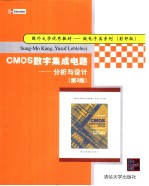

CMOS Digital Integrated Circuits:Analysis and Design (Third Edition)PDF电子书下载
- 电子书积分:18 积分如何计算积分?
- 作 者:Sung-Mo Kang Yusuf Leblebici著
- 出 版 社:清华大学出版社
- 出版年份:2004
- ISBN:7302090602
- 页数:626 页
Chapter1 Introduction 1
1.1 Historical Perspective 1
1.2 Objective and Organization of the Book 5
1.3 A Circuit Design Example 8
1.4 Overview of VLSI Design Methodologies 18
1.5 VLSI Design Flow 21
1.6 Design Hierarchy 23
1.7 Concepts of Regularity,Modularity,and Locality 25
1.8 VLSI Design Styles 28
1.9 Design Quality 38
1.10 Packaging Technology 41
1.11 Computer-Aided Design Technology 43
Exercise Problems 45
Chapter2 Fabrication of MOSFETs 48
2.1 Introduction 48
2.2 Fabrication Process Flow:Basic Steps 49
2.3 The CMOS n-Well Process 59
2.4 Layout Design Rules 66
2.5 Full-Custom Mask Layout Design 66
Exercise Problems 73
Chapter3 MOS Transistor 83
3.1 The Metal Oxide Semiconductor(MOS)Structure 83
3.2 The MOS System under Extemal Bias 87
3.3 Structure and Operation of MOS Transistor(MOSFET) 90
3.4 MOSFET Current-Voltage Characteristics 100
3.5 MOSFET Scaling and Small-Geometry Effects 112
3.6 MOSFET Capacitances 126
Exercise Problems 138
Chapter4 Modeling of MOS Transistors Using SPICE 143
4.1 Introduction 143
4.2 Basic Concepts 144
4.3 The LEVEL 1 Model Equations 146
4.4 The LEVEL 2 Model Equations 150
4.5 The LEVEL 3 Model Equations 154
4.6 State-of-the-Art MOSFET Models 155
4.7 Capacitance Models 156
4.8 Comparison of the SPICE MOSFET Models 160
Appendix:Typical SPICE Model Parameters 162
Exercise Problems 165
Chapter5 MOS Inverters:Static 166
Characteristics 166
5.1 Introduction 166
5.2 Resistive-Load Inverter 174
5.3 Inverters with n-Type MOSFET Load 183
5.4 CMOS Inverter 194
Exercise Problems 211
Chapter6 MOS Inverters:Switching Characteristics and Interconnect Effects 215
6.1 Introduction 215
6.2 Delay-Time Definitions 217
6.3 Calculation of Delay Times 219
6.4 Inverter Design with Delay Constraints 227
6.5 Estimation of Interconnect Parasitics 238
6.6 Calculation of Interconnect Delay 249
6.7 Switching Power Dissipation of CMOS Inverters 257
Appendix:Super Buffer Design 264
Exercise Problems 267
Chapter7 Combinational MOS Logic Circuits 271
7.1 Introduction 271
7.2 MOS Logic Circuits with Depletion nMOS Loads 272
7.3 CMOS Logic Circuits 284
7.4 Complex Logic Circuits 291
7.5 CMOS Transmission Gates(Pass Gates) 304
Exercise Problems 314
Chapter8 Sequential MOS Logic Circuits 320
8.1 Introduction 320
8.2 Behavior of Bistable Elements 321
8.3 SR Latch Circuit 327
8.4 Clocked Latch and Flip-Flop Circuits 333
8.5 CMOS D-Latch and Edge-Triggered Flip-Flop 340
Appendix:Schmitt Trigger Circuit 347
Exercise Problems 350
Chapter9 Dynamic Logic Circuits 354
9.1 Introduction 354
9.2 Basic Principles of Pass Transistor Circuits 356
9.4 Synchronous Dynamic Circuit Techniques 368
9.5 Dynamic CMOS Circuit Techniques 373
9.6 High-Performance Dynamic CMOS Circuits 377
Exercise Problems 394
Chapter10 Semiconductor Memories 399
10.1 Introduction 399
10.2 Dynamic Random Access Memory(DRAM) 404
10.3 Static Random Access Memory(SRAM) 432
10.4 Nonvolatile Memory 445
10.5 Flash Memory 458
10.6 Ferroelectric Random Access Memory(FRAM) 466
Exercise Problems 469
Chapter11 Low-Power CMOS Logic Circuits 475
11.1 Introduction 475
11.2 Overview of Power Consumption 476
11.3 Low-Power Design Through Voltage Scaling 487
11.4 Estimation and Optimization of Switching Activity 498
11.5 Reduction of Switched Capacitance 504
Exercise Problems 506
Chapter12 BiCMOS Logic Circuits 507
12.1 Introduction 507
12.2 Bipolar Junction Transistor(BJT):Structure and Operation 510
12.3 Dynamic Behavior of BJTs 522
12.4 Basic BiCMOS Circuits:Static Behavior 529
12.5 Switching Delay in BiCMOS Logic Circuits 531
12.6 BiCMOS Applications 537
Exercise Problems 540
Chapter13 Chip Input and Output(I/O) 544
Circuits 544
13.1 Introduction 544
13.2 ESD Protection 545
13.3 Input Circuits 548
13.4 Output Circuits and L(di/dt)Noise 553
13.5 On-Chip Clock Generation and Distribution 557
13.6 Latch-Up and Its Prevention 562
Exercise Problems 569
Chapter14 Design for Manufacturability 571
14.1 Introduction 571
14.2 Process Variations 572
14.3 Basic Concepts and Definitions 574
14.4 Design of Experiments and Performance Modeling 580
14.5 Parametric Yield Estimation 588
14.6 Parametric Yield Maximization 593
14.7 Worst-Case Analysis 595
14.8 Performance Variability Minimization 601
Exercise Problems 604
Chapter15 Design for Testability 608
15.1 Introduction 608
15.2 Fault Types and Models 608
15.3 Controllability and Observability 612
15.4 Ad Hoc Testable Design Techniques 613
15.5 Scan-Based Techniques 616
15.6 Built-In Self Test(BIST)Techniques 618
Exercise Problems 622
References 623
- 《中国雕塑》肇文兵著;Wang Wenliang,Kang Jian,Han Huizhi,Xiao Ying译 2010
- 《地理信息系统导论 第3版》Kang-tsungChang著;陈健飞等译 2009
- 《全球生产网络与东亚技术变革》Shahid Yusuf,M. Anjum Altaf,Kaoru Nabeshima编;中国社会科学院亚太所译 2005
- 《CMOS数字集成电路 分析与设计 第3版》(美)Sung-Mo Kang,(美)Yusuf Leblebici著;王志功,窦建华等译 2005
- 《响应式安全 构建企业信息安全体系》(新加坡)江明灶(Meng-Chow Kang) 2018
- 《地理信息系统导论》(美)Kang-tsung Chang著;陈健飞等译 2003
- 《COMBINATORIAL AND GEOMETRIC REPRESENTATION THEORY》SEOK-JIN KANG 2003
- 《CONFRONTING THE HUMAN RIGHTS ACT CONTEMPORARY THEMES AND PERSPECTIVES》NICOLAS KANG-RIOU 2012
- 《MICRO/NANO REPLICATION PROCESSES AND APPLICATIONS》SHINILL KANG 2012
- 《TECHNIQUES IN REVISION HIP AND KNEE ARTHROPLASTY》MICHAEL N.KANG 2015
